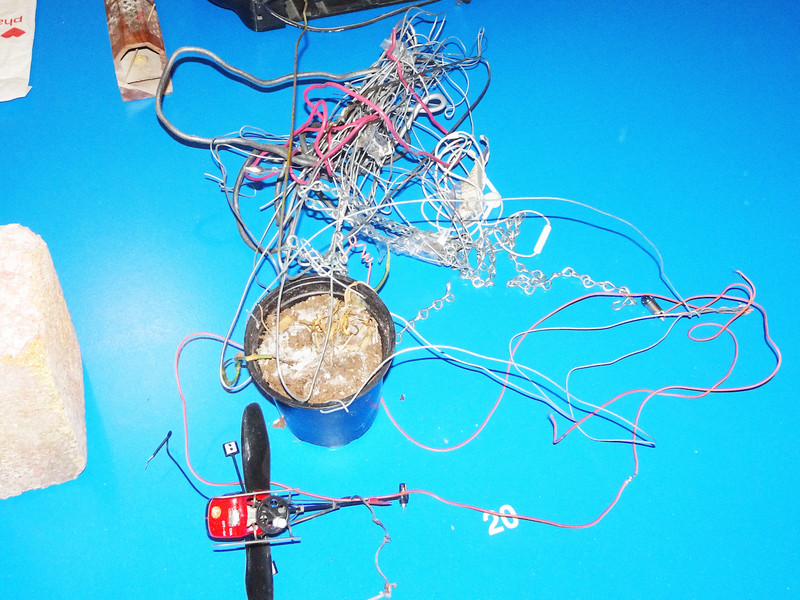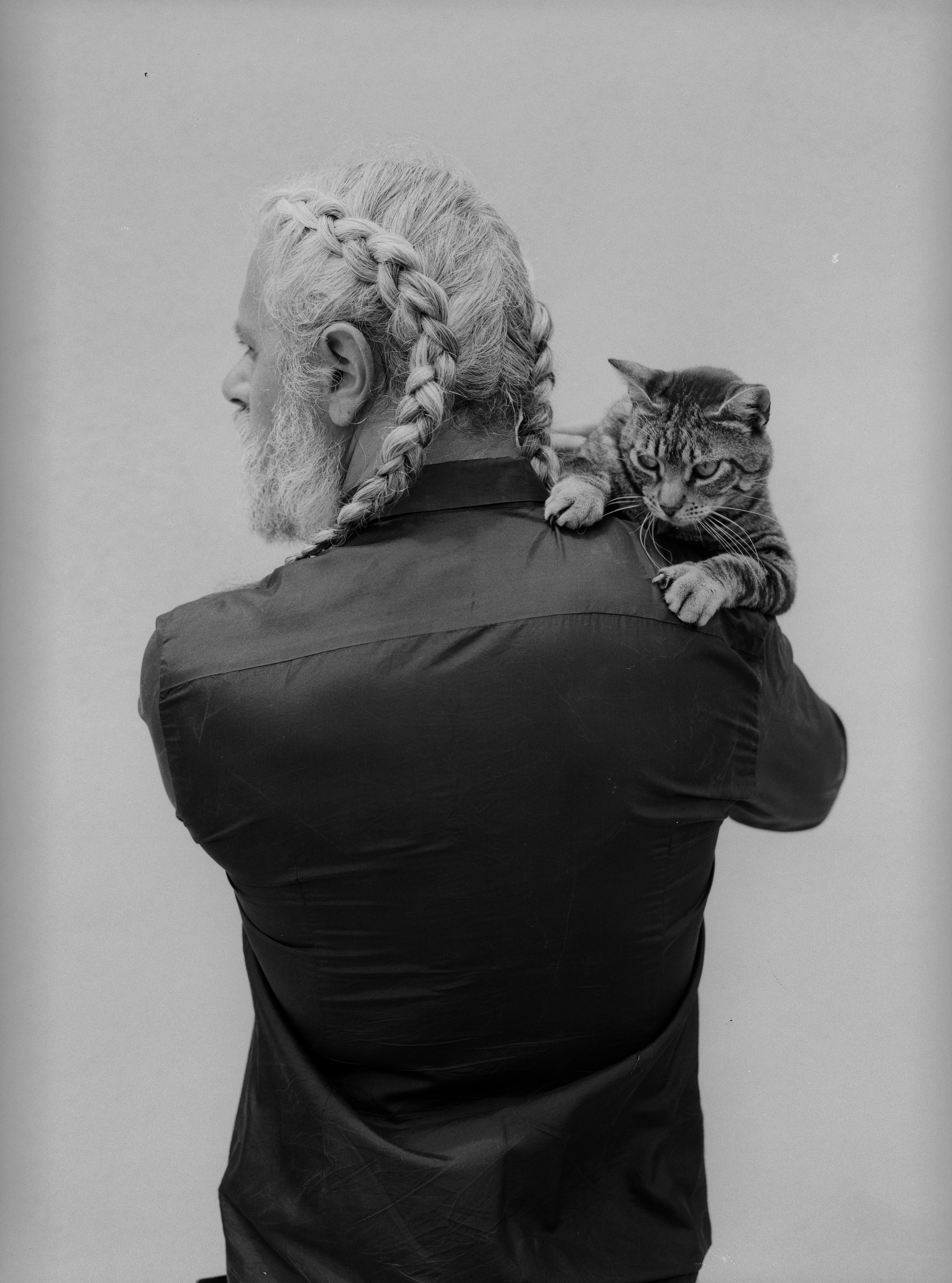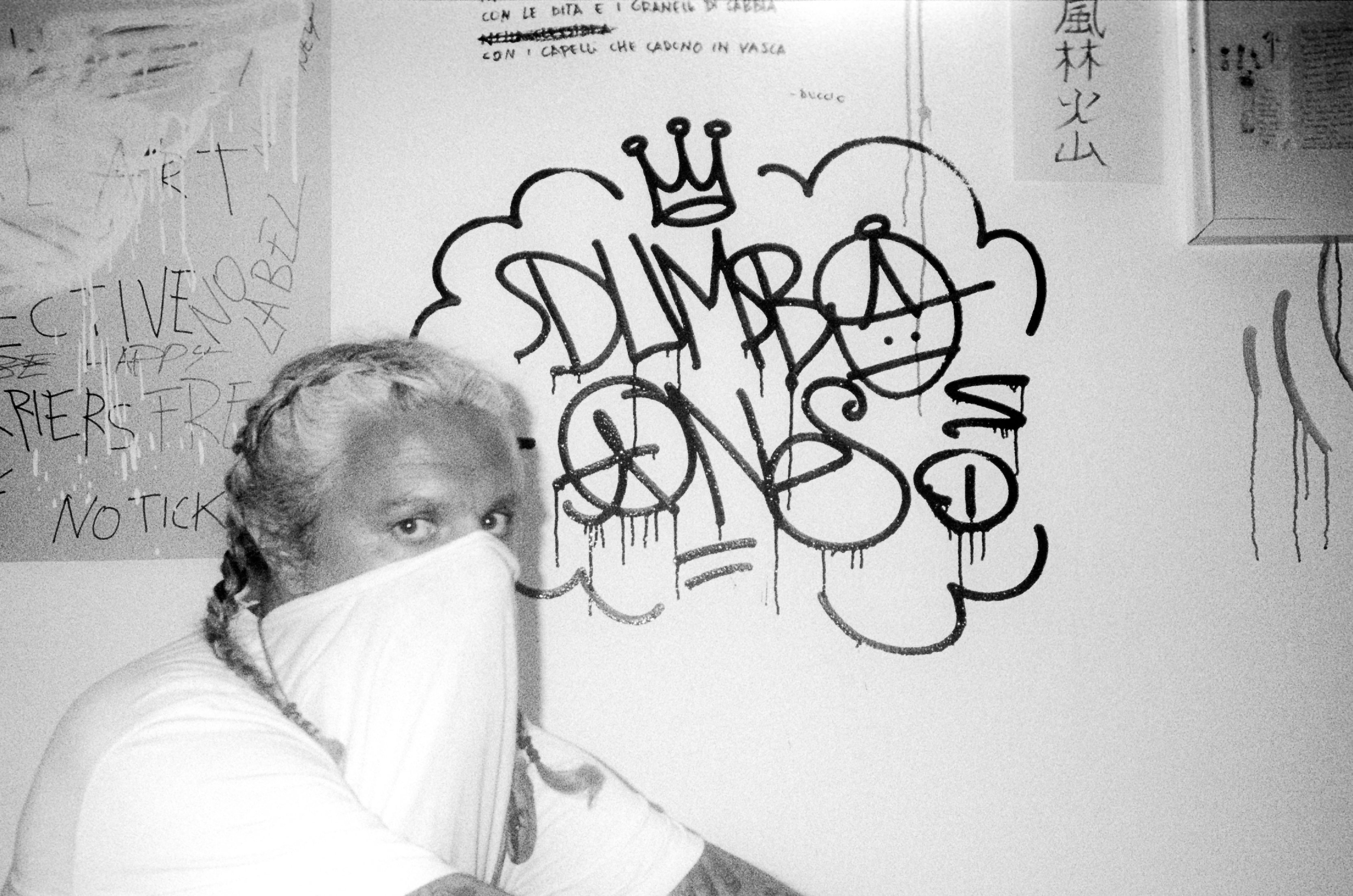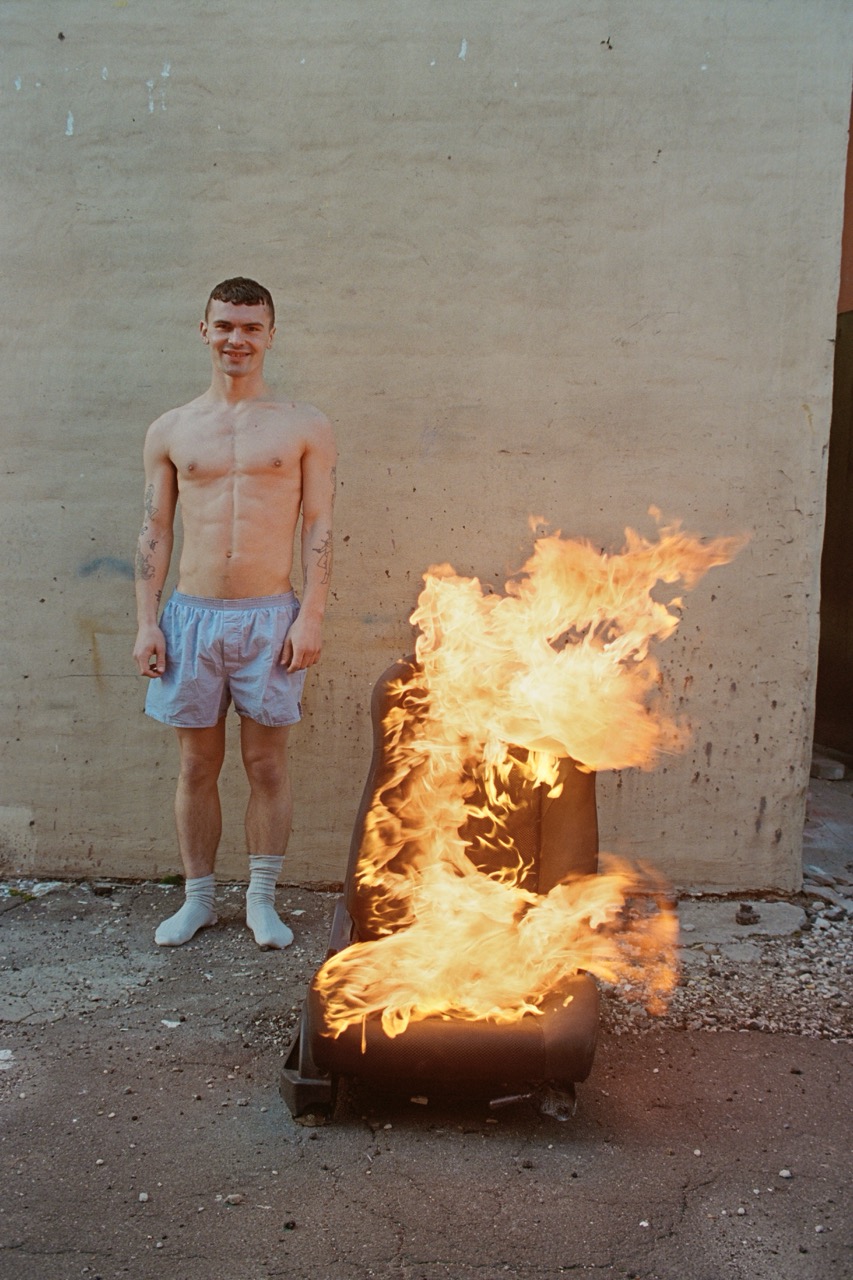Permission to Feel with Daisy Parris

It is almost as if we can feel Daisy’s heartbeat pulsing through the cotton threads. Each technical movement widens the hypothetical fissure within Daisy’s mind, spilling the vulnerable contents out for others to see, and encouraging them to open up in the same ways.
office dove into this intimate experience with Daisy, below.
There are many different things that audiences can take from your paintings through their own interpretations. Do you usually have an idea of what a piece will look like in your head by envisioning it beforehand or do they come to be in a completely abstract way?
I think, in the beginning, I mostly have a sense of what colors I'm going to use. So it starts with colors or a feeling or an emotion. Sometimes in my head it's one thing, and then when I make it, it ends up as another thing — which is even better for me. Because then I can be surprised as well. I have a 'go-to' mark, so often it starts off with that or with making the canvas dirty and then responding to those marks. All of the marks I use are very emotional. So those are the starting points and then I just let it go where it needs to go, basically.
There's definitely this sense of serendipity that you can feel just by looking at the work. The exhibition is called The Warm Glow, which I think is very fitting because many of the pieces bring out emotions in audiences that maybe you didn't even know were possible. What makes you feel warm?
It started off as this womb-like gesture, you know? Like the warmth of a womb and how that leads to being nurtured and feeling safe. My cats make me feel warm. They're the most nurturing thing to me, but a safe home is definitely my goal in life. The paintings — they come from quite a dark place. But actually, there's a lot of hope and light in them and that's this thread of warmth that I want to radiate when you see them all together. So it's good to take them out of the context of the anxiety of my studio and actually see that there are elements of hope and lightness in there.
Definitely. I think that element of hope comes from the idea that when you're looking at the pieces, it feels that they were created by someone working through emotions, through this artistic process. So, this is your first solo exhibition in New York. What did you feel when you learned that you would get to showcase for the first time in a new city?
It's definitely a dream come true for me. And especially to have it in the Bowery, which is an area of New York I'm really fascinated by and obsessed with, because of Basquiat having a studio there and the whole art scene there. It has that grunge element that suits me and my work well. Being able to have my work in that context — my mind is blown. 12-year-old me wouldn't believe it.


It's amazing, and it's a very artistic area for sure. So I have to imagine that that is such a milestone.
There's such soul in the Bowery and in James' gallery.
Definitely. Going back to this emotional aspect — I know that a lot of this exhibition is about combatting grief and tough emotions. I saw them as the personification of dealing with those types of feelings. Do you think that there is any true reconciliation in the unexplained, or do you feel like one of the best, or only, ways to work through those feelings is an outlet, such as the visual arts?
I need painting and painting is my savior in that way. It helps me work through stuff because there's something about not having to use words for everything. It allows me the space to obsessively think about and reflect on what I'm going through personally or what's going on in the world universally. I can dip in and out whenever I feel like it. It's not linear, and grief isn't linear. And emotions aren't linear. They always circle back around. So painting helps me in that way. I think as long as you're thinking about these feelings, then there can be reconciliation. But I'm looking at one of my paintings now, one of the small ones in the show, 'Poem for hate and Poem for death,' and I'm thinking about the fact that the only way to reconcile with those feelings is to invite them in or confront them head-on.
Yeah, I agree.
Whether that's through talking, thinking, or making. In this piece, I'm offering poems for these things I'm scared of. I'm scared of death and I don't understand it, but I'm writing poems as a gesture to kind of make peace with it, or become friends with it, or just try to learn more about it. So I think if you're open to showing yourself off, then you can reconcile with it. But I think some of the themes I'm dealing with, like death — there's a universal fear and fascination with that. I don't think that's ever gonna go away.
Confrontation is sometimes essential for growth.
Yeah. It's all gonna happen; there's no stopping it anyway.
You have different fragments within your work from oil and acrylic to little canvas scraps to bits of poetry. Do you feel that you're able to communicate more effectively through this type of medium than spoken word, at times?
Yes, because I've always been in my own head. So to talk about these things verbally, a few years ago, that would've been impossible for me. That's when I started exploring it and painting so I could be honest or uncensored about it because when I paint, it's my private safe space. I have nothing to lose, but I have to kind of trick myself into not thinking about the fact that these paintings are gonna be shown. Because, otherwise, I'd be too embarrassed. And that's not productive for me as a human and as an artist. So I've learned to separate the fact that anyone's going to look at them. Also while actually making them, it's really important for me to disconnect from that because when I'm making such emotional work, the hardest part now is accepting that they are being shown and I have to talk about it. But it's good for me to learn to navigate that too.
I feel when looking at your work, it's like being brought into your inner workings and the world that goes on inside of your head. It's very intimate. How would you describe what your head space looks like in this state of mind, when you're creating?
It's quite heavy. Riddled with anxiety at the start, when I'm feeling an emotion so deeply — which I basically feel all of them deeply. So a lot of the paintings start from a dark place, but as soon as I've confronted that, it almost pours out of me onto the canvases. And often, it's quite hard to go to that headspace, to paint. And I don't wanna be an artist that always has to go to that emotional state to paint. I don't think that's very healthy, so I'm trying not to do that all the time. That's where the lightness comes in. But at the same time, my studio is the place where I can do that and explore my darkest fears, but also my biggest dreams and biggest loves. Whatever emotion it is, I'm trying to channel it to the highest saturation.
And once you work through that, there has to be an immense sense of relief.
It's such a relief. I'm looking back at this show in New York with James and one in January with my London gallery, and I'm reflecting on how I even made that work with what I was going through. But at the same time, painting's the only thing that's always there for me, you know? The best feeling is that I've been able to turn those emotions into something creative or beyond what they were originally.
Your pieces are so multifaceted and there's so much that you can interpret from them. But there were some elements, down to specific brush strokes or patterns, that I noticed carried over within certain pieces. Is that intentional?
Definitely. I use this sort of criss-cross pattern or singular brush stroke.
Yeah, that's the one I noticed.
I've been using it for a couple of years. That started off as a representation of the depth of agony or anxiety, but it's ended up as something that just represents a growing energy that's trying to reach out and touch everything. And I find it quite a scary mark because it can end up taking over everything. But when I'm painting it, there's this kind of push and pull friction of, 'How far is it gonna go? How much is it gonna take over the canvas?’ Or is it just gonna linger in the corner? Sometimes in domestic spaces, you can feel the energy. There's just something there. So it just represents that feeling that it could take over at any time.
You really do feel this energy in the exhibition and it draws onlookers in. I think in that way, it also appeals to the senses. You know, it comes alive off of the canvas. There are not only emotions that come with that, but maybe even a smell or a certain feeling.
Exactly. I can feel it crawling over my body or I can imagine that that's where it started. I used to just do it in darker tones. But I guess with some of the lighter tones I'm using with that stroke now, I'm trying to think about how the dark energies aren't always what they seem.
Yeah, or they can be understood or spun to not always have that dark connotation. I also appreciated that along with this very sensory experience, there's also a textural element, especially with your use of fur. I was very curious about your use of color as well. Do certain colors represent certain emotions within your work? Have you now reconsidered the colors you use when you are feeling a certain way?
Yeah, I've definitely reconsidered and re-adjusted my scale of color in relation to my scale of emotions. When you're young at school, they teach you that red is angry. I've never felt that — I've always somehow been aware that emotions and colors aren't that simple. It's not black and white in a sense. So I really developed my own scale of emotions in relation to color, but at the same time, nothing is set in stone, and everything's fluid. Yellow in particular symbolizes hope for me, at the moment. I find it a really healing color. I'm also really drawn to red and pink; it's that kind of warmness that we talked about. But, they can be so violent as well. So I'm interested in the extremes of those colors. They can be nurturing, but brutal at the same time.


That plays into the dynamic qualities of your work and gives it a lot of nuance. The fact that color interpretation is different for everyone makes it kind of an interactive experience as well.
I love that. I love how all of the emotions can exist at once.
This exhibition as a whole is about processing emotions in difficult times. Learning from that process, I feel, is probably one of the most important parts. What is one self-reflective lesson that you learned while bringing these works to life?
I think it was that survival is possible. It always gets better. And just to not be scared of death. Those are quite heavy things, but —
And it's a difficult thing to not be scared of.
Yeah. It really is. But just to kind of have a relationship with it and think about it. Try not to be scared of it. I also think that remembering that you're not alone in it is one of the key things I've learned.
Daisy Parris’ The Warm Glow is on display at New York’s James Fuentes Gallery until July 15th.




















































